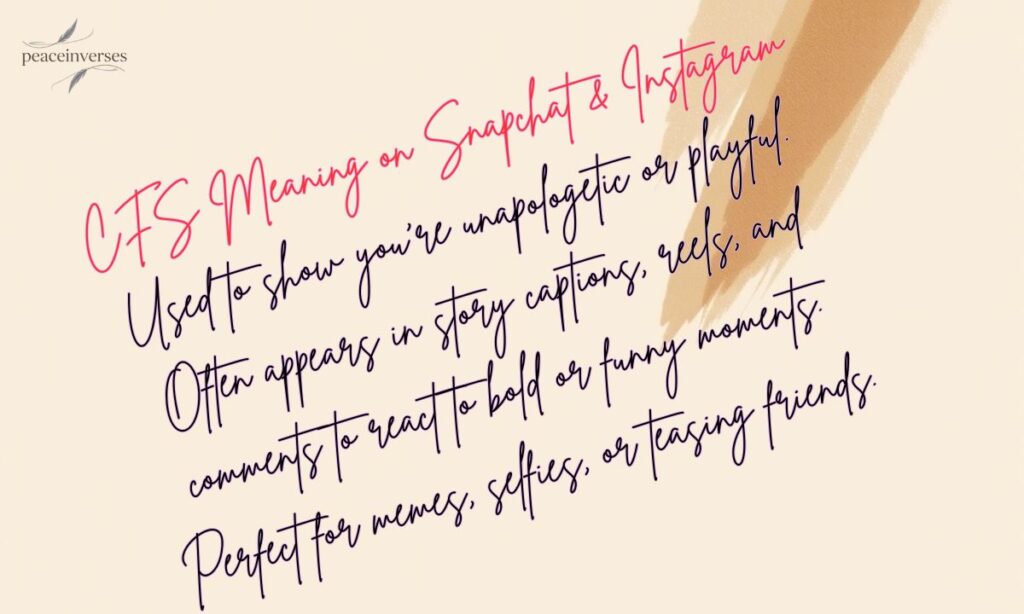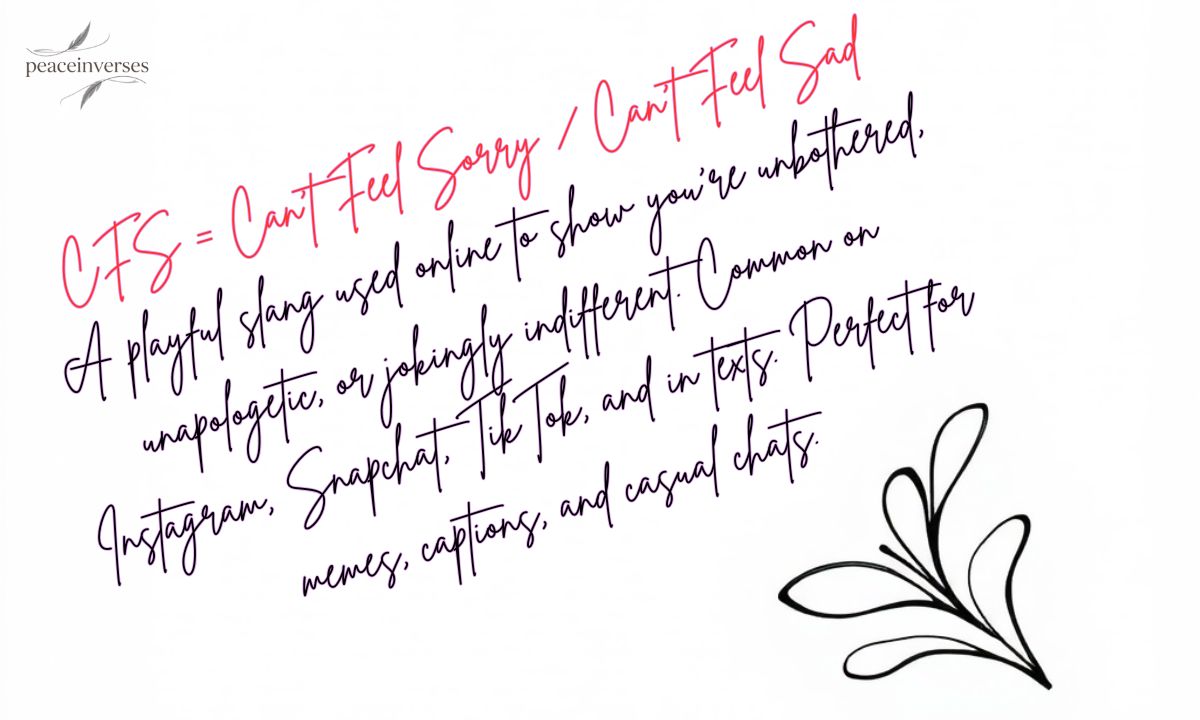Ever scrolled through Instagram or Snapchat and seen “CFS” but had no clue what it meant? You’re not the only one. Slang shifts so quickly that even daily users get lost. In 2025, CFS is trending everywhere, from captions to DMs, and it’s shaping the way people joke online.
CFS usually means “Can’t Feel Sorry” or “Can’t Feel Sad.” It’s a quick, cheeky way to say you’re not upset or apologetic. The phrase fits perfectly into fast-paced online chats, letting you show a shrug and a smirk with just three letters.
What Does CFS Mean in Slang?
CFS in modern slang usually stands for “Can’t Feel Sorry” or “Can’t Feel Sad.” It’s a playful way to say you’re not feeling guilty or emotional about something. This slang became popular on Snapchat, Instagram, and TikTok, where short words keep conversations quick. People use it when they want to shrug off drama or show they’re unfazed by small problems.
The term reflects the lighthearted tone of online culture. Instead of typing out a full explanation, users drop “CFS” to keep the mood fun. It often adds a hint of sarcasm or humor, signaling you’re not taking the situation too seriously. By 2025, it’s a go-to expression for playful indifference.
CFS Meaning in Text Messages
In text messaging, CFS saves time while delivering a strong reaction. Friends often use it to react to minor complaints, awkward moments, or teasing remarks. It replaces longer phrases like “I’m not sorry about that” or “It doesn’t bother me.”
For example, if someone texts, “You ate the last slice of pizza,” you might reply, “CFS 😅.” The abbreviation adds humor and keeps the exchange casual. Its popularity comes from how well it fits the fast-paced texting style most people use today.
CFS Meaning in Chat & Social Media
Across chat apps and social platforms, CFS shows up in captions, comments, and group messages. On Snapchat, it often appears in story captions to show a bold or unapologetic moment. On TikTok and Instagram, it’s commonly left under memes or videos where someone does something savage or funny.
In group chats, friends use CFS to tease one another without sounding harsh. It helps lighten the tone of conversations that might otherwise seem serious. The slang has become part of the casual language that defines online communities.
Funny & Sarcastic Uses of CFS
CFS often takes on a humorous edge when used to roast friends or double down on playful comments. For example, someone might post, “Skipped the gym again, CFS 😂.” It shows you’re aware of your actions but not upset about them.
This slang also works well in sarcastic situations. If a friend makes a dramatic statement about something minor, replying with “CFS” can make the moment funny. The mix of shortness, emojis, and tone makes it one of the most flexible slang terms online.
CFS Full Form in Slang vs. Other Meanings
While “Can’t Feel Sorry” is the most common meaning, CFS has other full forms depending on context. This can confuse new users who aren’t sure which meaning applies.
Here’s a simple table to clear it up:
| Context | Meaning |
| Slang / Texting | Can’t Feel Sorry / Can’t Feel Sad |
| Police / Dispatch | Call For Service |
| Medical | Chronic Fatigue Syndrome |
| Tech / Business | Cloud File System |
Knowing the situation helps you figure out which meaning fits best.
Common Non-Slang Uses of CFS
Outside of slang, CFS can refer to very different things. For example, in law enforcement, it’s short for “Call for Service,” describing a request for police or emergency help. In medical contexts, it often stands for Chronic Fatigue Syndrome, a long-term health condition that causes persistent tiredness.
In technology, companies sometimes use CFS to mean Cloud File System, describing data storage systems. These professional uses have no connection to the slang form. That’s why it’s important to look at the conversation’s context before assuming what CFS means.
CFS Examples in Real Conversations
CFS often pops up in casual chats to show playful indifference. For instance, when someone admits to skipping chores or eating a friend’s snack, they might add “CFS 😂.” It’s the perfect response to small slip-ups or jokes because it makes the tone lighthearted.
Here are some common examples you might see:
- “Skipped the gym again, CFS.”
- “He blocked me, CFS 🤷.”
- “Ate all the cookies, CFS.”
- “Dropped my phone, CFS 😂.”
- “Didn’t study for the test, CFS.”
These examples show that CFS works as a quick reaction in funny, casual situations without sounding harsh.
CFS Meaning on Snapchat & Instagram

On Snapchat, users often use CFS as a caption to highlight bold or unapologetic moments. For example, someone might post a story of buying something expensive and write, “Spoiled myself again, CFS 😎.” It’s a playful way to show confidence.
On Instagram, CFS is common in comments and reels where someone is being cheeky or savage. It’s often used to respond to memes or to tease a friend. In 2025, CFS is widely recognized on these platforms and has become part of their casual digital language.
How Gen Z Uses CFS on Stories and Comments
Gen Z loves slang that’s short and expressive, and CFS fits perfectly. On stories, they use it to add humor to everyday activities. A teen might post a photo of unfinished homework with the caption, “Didn’t even try, CFS 😅.”
In comments, CFS often replaces longer reactions like “not sorry about it” or “no regrets.” It’s a favorite because it saves time while sounding funny. Adding emojis helps keep the tone playful so it’s not mistaken for being rude.
When You Should (and Shouldn’t) Use CFS
CFS is best used in light and playful situations. It works well when teasing friends, captioning memes, or brushing off small mistakes. It adds a cheeky vibe without sounding too serious or mean.
Avoid using CFS in serious conversations where empathy is needed. It’s not suitable for comforting someone or discussing important matters. Using CFS in the wrong context can seem dismissive or even rude.
Do
- Use CFS when joking with friends who know your humor. Example: “Ate the cookies. CFS 😂”
- Add a playful emoji to show you mean it lightly. Example: “Left early. CFS 🙃”
- Combine it with self-deprecating humor when owning a mistake. Example: “Forgot the keys. CFS. My bad.”
- Match the tone of the chat. If everyone is joking, CFS fits.
- Use it in meme threads and light roasts where no one is vulnerable.
Don’t
- Use CFS after you learn someone is hurt. Example: Do not reply “CFS” to “I lost my pet.”
- Use it in professional or formal chats. Example: Avoid in work Slack channels.
- Use it to dismiss real concerns or mental health issues. Example: “I’m struggling” should get support, not CFS.
- Use it where power dynamics exist and people may feel targeted. Example: boss or elder.
- Assume it reads the same without emoji; silence can read cold.
Background & History
CFS began as internet shorthand in the early 2010s when texting culture pushed people to use shorter words. It wasn’t widely recognized until Instagram and Snapchat made quick captions and reactions trendy. Over the years, its meaning shifted from niche online jokes to a mainstream slang term that millions use daily.
By 2020–2025, CFS evolved into the playful phrase “Can’t Feel Sorry” or “Can’t Feel Sad.” This version caught on with Gen Z because it was bold, funny, and worked perfectly with emojis. Its rise shows how social media can turn a simple abbreviation into a cultural trend in online communication.
Key Points:
- Originated in early 2010s online chats.
- Grew in popularity with Snapchat and Instagram stories.
- Became widely known as “Can’t Feel Sorry” by 2025.
- Favored by Gen Z for humor and speed in texting.
- Reflects how slang evolves with social media culture.
Related Slang Abbreviations You Should Know
CFS is just one of many popular slang terms in 2025. Here are a few others that often appear alongside it:
| Slang | Full form | Tone | Example use |
|---|---|---|---|
| IDGAF | I Don’t Give A F*** | Aggressive | “IDGAF what they say.” |
| IDC | I Don’t Care | Neutral to dismissive | “IDC, next topic.” |
| SMH | Shaking My Head | Disapproving | “SMH, really?” |
| LOL | Laugh Out Loud | Light, amused | “LOL that was weird.” |
| NVM | Never Mind | Neutral | “NVM, figured it out.” |
| MFW | My Face When | Playful | “MFW I saw the meme.” |
| TBH | To Be Honest | Sincere or blunt | “TBH, that was awkward.” |
| FOMO | Fear Of Missing Out | Envious / playful | “FOMO hitting hard.” |
| TFW | That Feeling When | Relatable | “TFW you get free pizza.” |
| ICYMI | In Case You Missed It | Informational | “ICYMI, new episode dropped.” |
| SM | Social Media | Neutral | “SM is wild today.” |
| WC | Wild Card or Wrong Context | Depends | “Total WC move.” |
These abbreviations help keep online chats fast, funny, and expressive. Knowing them makes it easier to follow conversations and join in on the humor.
How to Respond to CFS
When someone drops CFS in a text or comment, it’s usually playful and not serious. Your response can match the tone—fun, light, and casual—without overthinking it. Keep it witty, supportive, or teasing depending on your relationship with the person.
Quick Ways to Respond:
- Reply with laughing emojis (😂😅) to keep it light.
- Tease them back with “Same 😂” or “CFS too!”
- Acknowledge it casually: “Noted 😎”
- Share a playful reaction GIF or meme.
- Keep it short and match their playful energy.
Frequently Asked Questions
What does CFS mean in slang?
It means “Can’t Feel Sorry” or “Can’t Feel Sad.”
Is CFS rude or offensive?
Not usually, but it can sound dismissive if used in serious situations.
Does CFS mean the same on all platforms?
Yes, across Snapchat, Instagram, and texts, it usually means being unapologetic.
Is CFS only for Gen Z?
No, but it’s most popular among Gen Z and younger millennials.
Can I use CFS in professional messages?
No, it’s best kept for casual chats and social media.
Conclusion
CFS is a short, witty expression that captures the playful side of online slang. It works best in jokes, memes, and casual chats where everyone understands the tone. By knowing when to use it, you can join the fun without sounding rude. As slang keeps evolving, CFS remains a go-to phrase for quick humor and lighthearted replies.

